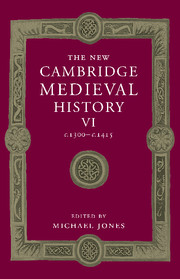Book contents
- Frontmatter
- Part I General Themes
- Part II The States of the West
- 13 The British Isles
- 14 France
- (a) The Last Capetians and Early Valois Kings, 1314–1364
- (b) France Under Charles V and Charles VI
- 15 Italy in the age of Dante and Petrarch
- 16 The empire
- 17 The Low Countries, 1290–1415
- 18 The Iberian Peninsula
- Part III The Church and Politics
- Part IV Northern and Eastern Europe
- Appendix Genealogical Tables
- Primary Sources and Secondary Works Arranged by Chapter
- Index
- Frontispiece
- Plate section
- Map 4 Europe's trade, c. 1300
- Map 5 Europe's trade, c. 1400
- Map 7 The Hundred Years War to 1360
- Map 15 Russia, c. 1396
- Map 17 The Byzantine empire in the 1340s
- References
(b) - France Under Charles V and Charles VI
from 14 - France
Published online by Cambridge University Press: 28 March 2008
- Frontmatter
- Part I General Themes
- Part II The States of the West
- 13 The British Isles
- 14 France
- (a) The Last Capetians and Early Valois Kings, 1314–1364
- (b) France Under Charles V and Charles VI
- 15 Italy in the age of Dante and Petrarch
- 16 The empire
- 17 The Low Countries, 1290–1415
- 18 The Iberian Peninsula
- Part III The Church and Politics
- Part IV Northern and Eastern Europe
- Appendix Genealogical Tables
- Primary Sources and Secondary Works Arranged by Chapter
- Index
- Frontispiece
- Plate section
- Map 4 Europe's trade, c. 1300
- Map 5 Europe's trade, c. 1400
- Map 7 The Hundred Years War to 1360
- Map 15 Russia, c. 1396
- Map 17 The Byzantine empire in the 1340s
- References
Summary
is it possible to write history centred on the reigns of individual kings sixty years after the first criticism by French historians of the factual and biographical methodology of political history? The answer must undoubtedly be, ‘yes’. Broadened by anthropological and sociological approaches, political narrative has been transformed into the history of power structures and of the developing state. And the figure of the king lies at the very centre of all these new fields of historical enquiry investigating the centres of power, its symbols and insignia, as well as the ceremonial and ritual of the state. As a result, the state itself is now viewed in a fresh perspective, but the king remains the primary focus.
Historical narrative, complete with dates and battles, has won back its place in this history of power structures, ever since the study of attitudes demonstrated that such historical facts provided a framework for corporate memories. In the 1420s and 1430s an advocate in the Paris parlement did not need to specify that he was talking of the battle of Agincourt in 1415 when he dated a fact to ‘the year of the battle’. The narrative approach has regained its place in historical studies, but its emphasis has changed dramatically since the days of Ernest Lavisse and the positivist historians of the nineteenth century.
- Type
- Chapter
- Information
- The New Cambridge Medieval History , pp. 422 - 441Publisher: Cambridge University PressPrint publication year: 2000

